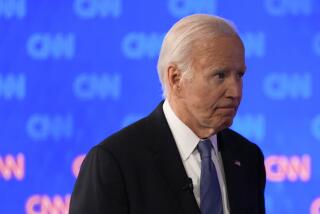CALIFORNIA ELECTIONS / BOND MEASURES : Backers Fear Voters’ Aversion to New Debt
Three seemingly non-controversial bond measures seeking to raise funds for earthquake safety, schools and colleges--usually considered good causes all--face a formidable obstacle in the June 7 election.
While there is no organized effort with a fat campaign treasury to oppose the measures, backers concede that their challenge is to overcome voter reluctance to increase the state’s debt.
The three measures would authorize almost $4 billion worth of borrowing to pay the costs of earthquake rebuilding and new construction at educational institutions. Additionally, on the same ballot, backers of parkland expansion are asking voters to approve $2 billion in bonds.
For years in California, the passage of bond issues was a virtual certainty at the polls, but that changed in recent elections.
In June, 1992, despite support from Gov. Pete Wilson and other well-known figures, a $1-billion bond issue proposal to help finance an expansion of rail transit service in California was soundly defeated. In November, 1990, 12 out of 14 bond proposals were rejected by voters, including measures that would have provided money for the purchase of ancient forests, the expansion of college campuses, prison construction and park acquisition.
“I think voters are beginning to realize that there is no such thing as free money and that these bonds are repaid at enormous expense by future taxpayers. We’ve seen that realization growing in recent elections,” said Tom McClintock, a former state assemblyman and an opponent of the measures.
Kirk West, California Chamber of Commerce president and a leader of the campaign to pass the earthquake repair proposal known as Proposition 1-A, acknowledged that while the polls show his initiative winning by a wide margin, he is concerned that polls do not measure the impact that the bond issues could have on each other.
“I think it’s a legitimate worry,” he said.
Besides Proposition 1-A, Propositions 1-B and 1-C would authorize bond funds, respectively, for construction projects at state-supported colleges and universities and for public schools through high school. Add to that the park funding measure--Proposition 180--and voters on June 7 will decide on $6 billion in bonds, the most ever proposed in a single election.
Even so, backers are hopeful that voters will not reject all the bond measures but will pick and choose among them. None of the supporters have raised enough money to finance a major campaign, although West hopes to collect $100,000 for a campaign mailing touting Proposition 1-A.
Supporters of Proposition 1-B argue that their proposal will help schools catch up with much needed maintenance and construction that was deferred during the years of state budget crises. The proposals would authorize $1 billion in bonds to finance construction, renovation and seismic safety projects for public schools.
A similar argument is employed by the backers of Proposition 1-C, which authorizes another $900 million in bonds to pay for construction, renovation and seismic safety projects at California’s public colleges and universities. West, meanwhile, is banking on California’s latest and most expensive natural disaster--the Jan. 17 Northridge earthquake--to help him sell the quake repair measure.
He says Proposition 1-A will pay California’s share of costs from the Northridge earthquake without raising taxes and provide funds for the seismic strengthening of highway bridges.
Proposition 1-A was approved by the Legislature as the means to finance the state’s share of earthquake costs after Republican Wilson, who is seeking reelection, balked at a Democratic proposal for a temporary sales tax increase. To make the measure more palatable to voters outside Los Angeles, $950 million was earmarked for accelerated bridge retrofitting programs elsewhere in the state.
All the bridges in the Los Angeles area that had been seismically strengthened withstood the Northridge earthquake, but six that had not been retrofitted collapsed.
The collapses forced attention on the retrofitting program, which was found to be lagging far behind schedule. Indeed, four years after the Loma Prieta quake crushed to death 43 motorists under a collapsed freeway in Oakland, 80% of the highway bridges considered vulnerable to earthquake damage still had not been retrofitted.
West said the bond issue is now the only way that the state can quickly raise the large amount of cash needed to finance an accelerated retrofitting program. Without the bond funds, he warned, safety hazards will persist.
“If you put this off and do this gradually and do not accelerate the retrofitting,” he said, “it could be a very dangerous gamble. And it must be remembered it is much cheaper to retrofit than to reconstruct after an earthquake.”
McClintock disagreed, saying there are cheaper ways than bond issues to pay earthquake and campus construction costs. He said the state would have the quick cash necessary to cover those costs if Wilson and lawmakers were only willing to make more cuts in state spending.
In contrast, he said, bond issues are among the most expensive forms of government financing. While the three construction bond issues would raise nearly $4 billion, it would cost about $7 billion over the 25-year life of the bonds to pay principal and interest, assuming a 6% interest rate.
More to Read
Get the L.A. Times Politics newsletter
Deeply reported insights into legislation, politics and policy from Sacramento, Washington and beyond. In your inbox three times per week.
You may occasionally receive promotional content from the Los Angeles Times.






